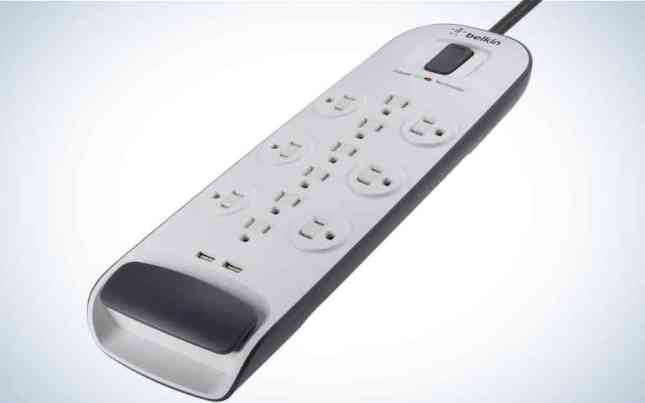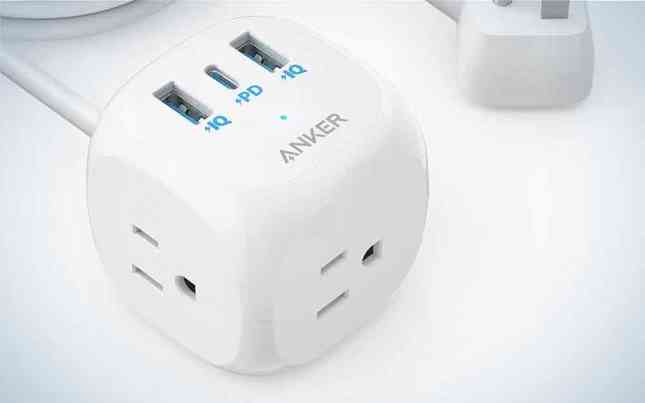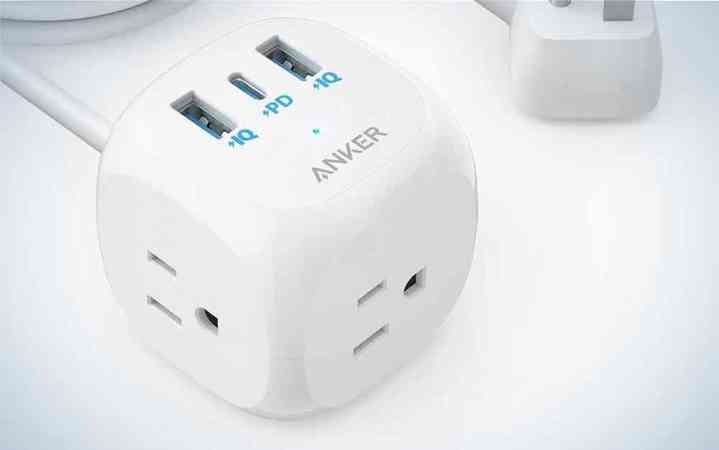We may earn revenue from the products available on this page and participate in affiliate programs. Learn more ›

A USB power strip solves a common problem: filling every outlet in your home with a power plug for your phone, tablet, computer, smartwatch, or other tech accessories. Power adapters for these devices are small, but they’re taking up valuable real estate that could be used to keep appliances plugged in all the time. If you’ve ever spent any time rearranging power adapters underneath your work desk and getting confused about which one goes to what gadget, you’ll understand the utility of this tech accessory. The best USB power strips will keep your most commonly used portable devices charged and ready for the day ahead without bumping power-hungry ones off the grid.
- Best overall: Austere VII Series 6-Outlet with USB-C PD
- Best travel friendly: Anker Nano Charging Station
- Best design: TP-Link Kasa Smart Plug Power Strip HS300
- Best for larger adapters: Belkin 12-Outlet Surge Protector
- Best budget: Anker 20W USB-C Power Strip
How we chose the best USB power strips
Our recommendations for the best USB power strips come from a mix of hands-on testing and research. Despite their utility, these are relatively low-tech gadgets with a single job: keeping your devices charged and powered. That said, we factored in their size, how many outlets they have, which USB ports are featured, and any other extra features when determining which ones made the cut. You’ll be able to find a great USB power strip regardless of your power needs, space constraints, and budget. You can rely on our recommendations to remain a permanent, well-used part of your home theater or office setup for several years.
The best USB power strips: Reviews & Recommendations
This may not be the most glamorous gadget, but it’s still important to take the time to learn the ins and outs of all your options. Our guidance can help you make the right choice, so the only thing you’ll have to think about is which gear to plug into your USB power strip.
Best overall: Austere VII Series 6-Outlet with USB-C PD
Austere VII Series 6-Outlet with USB-C PD
Specs
- Number of outlets: 6
- USB Ports: 5 (3 USB-C, 2 USB-A)
- Surge protection: 4,000 Joules
Pros
- Myriad USB ports
- Sleek look
- Surge protection
Cons
- Price
We’ve been testing Austere’s VII Series 6-Outlet with USB-C PD for several months, and it’s provided rock-solid performance in a well-constructed package. The USB power strip has five USB ports and six outlets. Critically, one of the USB-C ports can supply up to 45W of power, which is enough to charge a laptop. All of this power strip’s USB ports are on the bottom, far away from its outlets. This allows you to organize your area a little more neatly. You’ll never accidentally yank out a power cord when trying to unplug your phone’s charging cable. In practice, this design has worked out really well, and we hope it becomes the industry standard.
We used this power strip’s USB ports to charge phones, laptops, tablets, Bluetooth speakers, Bluetooth earbuds, and other portable devices. The cables fit into the VII Series’ USB ports snugly and securely and never popped out, even when the power strip was moved around. Similarly, we connected computer monitors, powered speakers, vacuums, and everything in between to the VII Series’ outlets and had an identical result. The outlets were spaced far enough apart that we could finagle large power adapters next to one another without incident.
We were continually impressed by the VII Series’ overall build quality during our tests. It’s uncommon for such a basic gadget to look and feel so luxurious. The aluminum Austere used for the USB power strip’s chassis makes it feel as nice as a MacBook. The company even paid attention to the cable connecting the power strip to your wall; it’s thick, braided, and has sufficient reinforcement around the connector so it won’t fray. Austere says its USB power strip can insulate electronics from up to 4,000 joules of power spikes. If you’re in an area with many thunderstorms or your home’s electricity is so-so, this is a big feature.
All of these features contribute to the VII Series’ high price. This is the only USB power strip we recommend that costs over $62, but its performance and build quality are unmatched. If you want each component in your home theater or office to be top-notch, Austere’s VII Series 6-Outlet with USB-C PD is peerless.
Best travel friendly: Anker Nano Charging Station
Anker Nano Charging Station
Specs
- Number of outlets: 2
- USB Ports: 4 (2 USB-C 2 USB-A)
- Surge protection: Yes
Pros
- Compact, flat design
- Pleasing design
- Multiple USB-A and USB-C ports ports
Cons
- Only two outlets
Every inch of space counts when you’re packing, which makes Anker’s Nano Charging Station a no-brainer for frequent travelers. You can plug up to six devices into its assortment of outlets and USB ports. It only has two outlets, which may be one too few depending on the devices you carry, but if you’re mostly packing laptops, tablets, and smartphones, the pair of USB-C ports on the Nano Charging Station will provide sufficient power. One of those USB-C ports can output up to 67 watts of electricity when none of the other USB ports are in use, which is enough juice to fully recharge a 13-inch MacBook Pro in under two hours. When multiple devices are connected the 67 watts are distributed between all four ports, though the USB-C ports will receive more than the USB-A ports.
In out tests the Anker Nano Charging Station worked perfectly both domestically and when connected to a basic power converter when traveling in Europe. The power strip’s ultra thin profile made it easy to pack in our backpack, while its five foot long cable was long enough to give us multiple placement options when using it in AirBnbs and hotel rooms where outlets were scarce and located in hard to reach areas. The power cable itself is ultra slim, which made it possible to connect the power strip to outlets located behind dressers, beds, and other furniture.
If you’re a wanderlust who sees packing efficiently as the only way to go, pick up Anker’s Nano Charging Station.
Best design: TP-Link Kasa Smart Plug Power Strip HS300
Specs
- Number of outlets: 6
- USB Ports: 3 USB-A
- Surge protection: Yes
Pros
- WiFi-enabled
- Fits in a big smart home ecosystem
- Sleek look
Cons
- No USB-C ports
TP-Link’s Kasa Smart Plug Power Strip HS300 is way more technically advanced than our other recommendations and could very well become a central part of your smart home. Each of its six outlets can operate as its own smart plug, which you can manage through the Kasa app on your iOS or Android device. This allows you to change the power state of any device connected to the outlets on and off. You could use this feature to turn on a lamp in your living room before heading to it or turn off your receiver if you accidentally forgot earlier.
These smart features are complemented by three USB-A ports, perfect for charging a smartphone and other smaller electronics. We wish TP-Link would update the HS300 with USB-C ports, but most of its design time was dedicated to ensuring six smart plugs could be operated from a single power strip. Like most of TP-Link’s smart home accessories, the HS300 doesn’t require a hub to work and can be controlled via an Amazon Alexa or Google Home-enabled speaker.
If your current power strip is filled with smart plugs, or you want to have complete control over a cluster of smart-home accessories, this is the best USB power strip you can get.
Best for larger adapters: Belkin 12-Outlet Surge Protector
Belkin 12-Outlet Surge Protector
Specs
- Number of outlets: 12
- USB Ports: 1 USB-C, 2 USB-A
- Surge protection: Yes
Pros
- A lot of outlets
- Surge protection
- Wall mountable
Cons
- Bulky
We’ve all had the unfortunate experience of having to move power adapters around on a power strip because they wouldn’t fit next to one another. Belkin’s USB Power Strip makes this a non-issue. Half of its outlets are oriented vertically, while the other half face outward. The second set is spaced far enough apart that any-sized power adapter will fit without bumping into another one. We recommend using the vertically-oriented outlets for slimmer power plugs, which don’t run any risk of interrupting one another.
This plethora of outlets is complemented by two USB-A ports and one USB-C port, which can supply power to small and medium-sized electronics like phones, tablets, and portable game consoles. Belkin’s USB power strip is also a surge protector that can handle surges of up to 4,000 joules, so your devices will be safe in case of a sudden energy fluctuation.
The only downside to using a USB power strip with this many outlets is that it’s larger than our other recommendations. You can mount it to a wall, which is a pretty solid solution, but the power strip’s long power cable will make your setup look a little inelegant. Still, this power strip’s sheer utility outweighs that minor complaint.
Best budget: Anker 20W USB C Power Strip
Anker 20W USB C Power Strip
Specs
- Number of outlets: 3
- USB Ports: 3 (1 USB-C, 2 USB-A)
- Surge protection: No
Pros
- Price
- Port assortment
- Size
Cons
- Fewer outlets
Anker’s 20W USB C Power Strip is an excellent deal in the entire world of tech accessories, not just its own category. For under $15, you get a compact three-outlet power strip with two USB-A ports and one USB-C port. Its smaller size means fewer outlets than most of our recommendations, which is the only potential flaw. This won’t be an issue if you don’t have too many electronics.
We’re very pleased with this USB power strip’s cubic shape, which allows you to plug three big power plugs into it without the risk of them bumping into one another. It doesn’t offer any surge protection, but that’s to be expected from a power strip in its sub-$20 price range. Anker does offer a seven-point safety system, which can prevent common issues like overloading and short-circuiting from damaging your electronics. Additionally, the company offers an 18-month warranty with up to $200,000 in reimbursement if your gadgets get damaged while connected to this power strip during everyday use.
Anker’s solution should be sufficient if you’re curious about trying a USB power strip or don’t have heavy power needs.
What to consider when shopping for the best USB power strips
There are many factors to weigh when deciding on the best USB power strip for your needs. We’ve highlighted the ones that we considered most important when selecting the recommendations for our guide.
Number of outlets
USB ports are the main advantage of getting this type of power strip, but you’ll still need enough outlets for your more energy-hungry electronics. We recommend getting a USB power strip with two or three more outlets than you currently need to account for changes in your work or home theater setup. Travel-sized power strips have fewer outlets because of their smaller size, but you’ll probably have fewer gadgets to plug in while on the go.
Types of USB ports
There are two types of USB ports found on the power strips we’re recommending: USB-C and USB-A. USB-C ports can output far more power, and many newer gadgets can take advantage of that thanks to fast charging features. USB-A ports can output less power, but are still sufficient for charging smartphones, Bluetooth speakers, and other smaller electronics.
Surge protection
Some USB power strips also offer surge protection. A surge protector has mechanisms built into it that prevent fluctuations in power or other abnormalities—like power surges—from overloading and potentially damaging the electronics connected to it. A USB power strip without surge protection will simply provide gadgets with the power they need to run and may have other less sophisticated damage prevention features.
FAQs
There shouldn’t be any issues with leaving your USB power strip on all the time unless you’re overloading it. Be sure to read the specifications for your power strip and the attached gadgets to ensure it’s not being overburdened. The quality of your home’s electricity will also play a big role—if the outlet your power strip is plugged into can’t supply enough juice, you will run into problems.
A USB power strip can last a decade or more if it’s not being overloaded.
Yes. Any gadget plugged into an outlet will draw a meager amount of power, even if there’s nothing connected to it.
Any gadget can be plugged into a power strip. You’ll only run into a problem if your electronics are drawing too much power at once.
No. Unplugging a power strip will draw no electricity from the wall. Turning it off will still draw some power from the wall.
This depends on their feature set, the number of outlets they have, and their size. Depending on your needs, you can spend as little as $20 or almost $200.
Final thoughts on choosing the best USB power strips
- Best overall: Austere VII Series 6-Outlet with USB-C PD
- Best travel friendly: Anker Nano Charging Station
- Best design: TP-Link Kasa Smart Plug Power Strip HS300
- Best for larger adapters: Belkin USB Power Strip
- Best budget: Anker 20W USB-C Power Strip
A USB power strip is a tech accessory that makes total sense but is easy to overlook. You’ll be able to reduce the number of USB power adapters plugged into your walls and invest in more durable charging cables instead. Our tests have proven that the best of these power strips can make an appreciable difference in the overall quality of a work setup. Having an extra outlet or being free of the annoyance of constantly plugging and unplugging different devices prepares you for different work situations. This is the type of simple upgrade that you’ll be kicking yourself for not making earlier.
Why trust us
Popular Science started writing about technology more than 150 years ago. There was no such thing as “gadget writing” when we published our first issue in 1872, but if there was, our mission to demystify the world of innovation for everyday readers means we would have been all over it. Here in the present, PopSci is fully committed to helping readers navigate the increasingly intimidating array of devices on the market right now.
Our writers and editors have combined decades of experience covering and reviewing consumer electronics. We each have our own obsessive specialties—from high-end audio to video games to cameras and beyond—but when we’re reviewing devices outside of our immediate wheelhouses, we do our best to seek out trustworthy voices and opinions to help guide people to the very best recommendations. We know we don’t know everything, but we’re excited to live through the analysis paralysis that internet shopping can spur so readers don’t have to.







